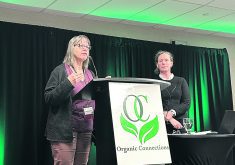Glacier FarmMedia – Public disconnect from agriculture and misunderstanding of agricultural processes may be causes for regulatory concern, attendees of a recent Protein Industries Canada conference heard.
Canada is a world leader in agricultural innovation and has set the standard for gene editing and plant breeding regulations, said speakers on one panel about regulatory reform. But when the public doesn’t understand how those things work in the production process, “fractured” policy can result.
Regulations and mandatory food labelling are necessary for food safety and nutrition, panelists noted, but may discourage new entrants in the sector who don’t understand the reasons.
Read Also

Trade war may create Canadian economic opportunities
Canada’s current tariff woes could open chances for long-term economic growth and a stronger Canadian economy, consultant says — It’s happened before.
“Some of the smaller players, they just don’t want to touch that risk; they don’t want to get involved,” said Chad Koscielny, Corteva Agriscience North American canola breeding lead.
“So then it really limits the amount of participation you have in these new technologies. And if you can “de-risk” it to the point where you have more players involved, it increases competition, it increases innovation and it continues to drive us forward.”
The discourse on genetically modified organisms is an example. A cross-section of the public believes GMOs are harmful and needless, noted panellists, but those in agriculture say many crops are only viable because of GMOs.
Better public awareness about all stages of agriculture is one part of the two-part issue of regulation, panelists said. The other is the need for transparent communication from researchers, innovators and marketers.
Ian Affleck, CropLife Canada vice-president of plant biotechnology, said the public is often unaware of agricultural problems that underpin development of new products or technologies.
“When you get to a plant variety that’s going to help you do something in the ag sector, you’re so far removed from the public that their interest in understanding constructive technology is minimal. So, we have to figure out how to bridge that gap and make sure we’re communicating early and often, especially with gene editing.”
Early transparency would provide context and reasons for the product’s creation, instead of creating public worry when it’s launched, Affleck added. Sharing knowledge is also likely to determine the needed communication and marketing steps when that product comes to market.
Angela Bedard-Haughn, University of Saskatchewan dean for the College of Agriculture and Bioresources, says it is an important step to address.
“I do think that we need to continue thinking about how we’re educating everybody about what agriculture is, what innovations are, what that constitutes,” she said, and that process should start early.
“So, like primary school and how we’re talking about science, how we’re talking about agriculture.”
The 2021 Agriculture Canada Agri-Awareness Research Report revealed that, while the public has general trust in the ag sector and is sympathetic to its challenges, people generally don’t understand the how and why of the industry.
Survey participants said they’d like to know more about farming costs and challenges, technology, criteria for GMOs, food contents and how it’s grown.
“If we want to have successful future market innovations, we need to start rebuilding that trust in agriculture and agricultural innovation at the school level, and then follow that all the way through,” said Bedard-Haughn.
















